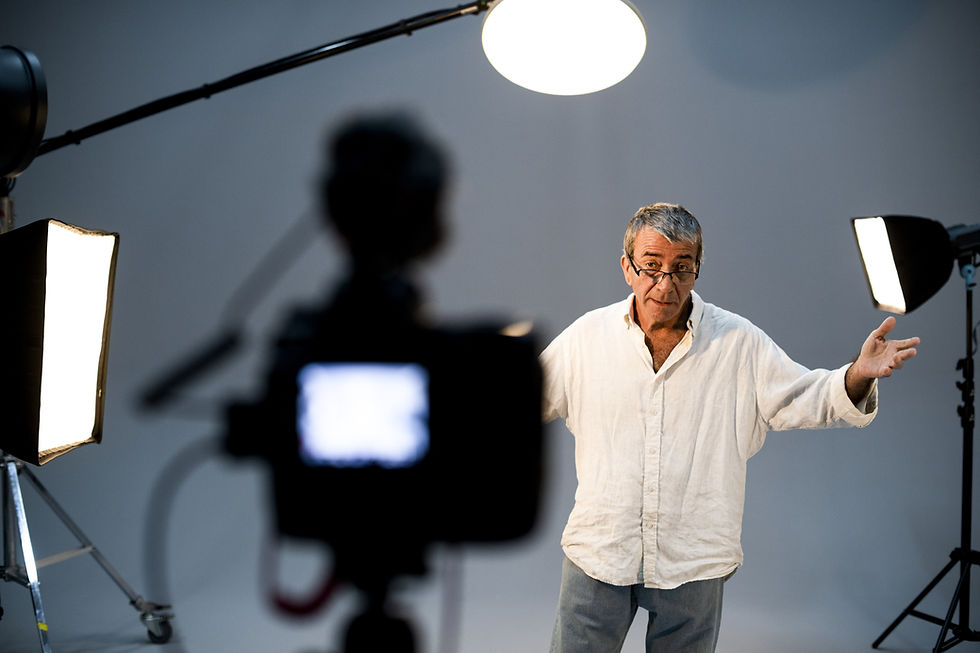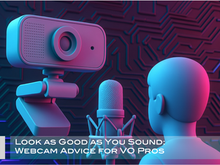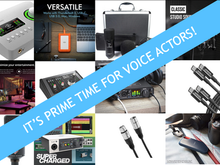Point and Shoot! Why a Shotgun Mic might be Right for You!
- Frank Verderosa
- Apr 8, 2022
- 5 min read
Updated: Feb 2
While listening to one of the many Voice Actor chats on Clubhouse recently, I stumbled upon a comment from an "engineer that's been working for 30 years" regarding shotgun microphones. He said, "Those mics are not for voice work and shouldn't be used". In a recent Facebook thread about shotgun mics, another person pointed out that a famous voice actor absolutely hated their voice on the shotgun, and they had no place in a studio". Everyone is entitled to their opinion. But these folks happen to be wrong.
These days, most studios offer the Senheiser 416 alongside the ubiquitous Neumann U87 (or similar). But the 416 wasn't designed for voiceover work. It was originally designed as a boom mic or film and TV set recording. Anyone who has purchased the 416 has probably noticed that tiny mic cable that it comes with. That's for attaching it to a boom pole... not an error in mic cable length. And while the 416 runs around $1,000- you might also consider the Synco D2, which currently sells for $223 If you haven't already seen it, check out the Booth Junkie YouTube video comparing the two!
I want to talk about why these mics work so well, and address some of the poor advice given on how to set them up!
Is a shotgun mic right for your booth?
When I consult with voice actors on gear and booth setups, the amount of space they have to work in often informs the mic options I'll suggest. Large diaphragm condenser microphones (U87, TLM103, Rode NT1, Stellar XR, etc) gives a lot of detail and richness to voice over work- but their polar pattern allows for more reflections to enter the sides of the mic. That's fine in a larger booth, but when you're in a tight space comb filtering becomes a big issue. Even foam treated walls reflect some sound, and when those waveforms bounce back at your mic too close to a wall, you're going to get that super boxy sound. There is currently no fix for comb filtering, and you can't EQ your way out of it. The polar pattern of a shotgun mic rejects a lot more side information, leaving a very focused forward facing pickup field, with a smaller rear pickup. It is much more forgiving of tight spaces or smaller booths.


Do you also do on-camera auditions?
Because shotgun mics were designed for very focused pickup on film sets, if you're doing on-camera auditions as well as VO work- this might be the the mic for you! You can mount your mic barely out of frame from above, and get an excellent audio recording- even if the camera is a distance away! If you're using your Iphone or Ipad to capture video, you can use device specific interfaces like the IRig Pro, or even the Focusrite Scarlett Solo (with an added adaptor to allow USB bus power while connecting to the lightning port).

Are you also planning on using it for singing?
You need to consider all the ways you're going to use a shotgun mic. If you're a voice actor that is also a singer, you might not get the kind of warmth you're expecting from large diaphragm condenser mics. If the singing work you're going to do is limited to a cartoon character singing a few lines in an episode here and there, then you'll be fine with a shotgun. But if you're a jazz vocalist recording your next album from home- you might want to consider a second mic for that task, or stick with one of the larger condenser mics.
Getting it right!
One of the most frustrating thing I've encountered over the past two years of working directly with voice actors on their home studios has been fixing bad information handed out by people that probably ought not be giving advice. And no, I'm not even trying to be gentle about this comment. It actually makes me angry to see people paying good money for horrible advice. The most frequent issue is mic placement. In the early days of the pandemic, an actor reached out to have their sound evaluated. The sound wasn't good- but they had a Senheiser 416, and I was curious how it could sound so bad. When we got on Zoom, I could see their mic pointing toward the floor, with the actor talking more or less into the side of the mic. I quickly said "Oh, I see the problem! That's not how that mic goes! Raise it up, and angle it about 30 degrees and point it toward your nose. Send me a new recording this way!". The sound difference was dramatic, and they sounded great. But their face fell. When I asked what was wrong, they explained that they had paid a couple of hundred dollars for some really bad information, and that I had just fixed the problem for a fraction of that cost. He wasn't the only person. I find myself constantly having to clean up someone else's mess created by overpriced bad advice.
Positioning and Benefits:
Your shotgun mic for voice acting wants to be at about a 30 degree angle, aiming down at your nose. This allows you to speak freely with your air going under the mic, all but eliminating the possibility of plosive pops. If you've ever stood in front of a larger condenser mic with a pop screen, you know the challenge of trying to read copy through it all! The shotgun mic occupies very little of your field of view, and doesn't require a big pop filter. In fact that included foam sleeve does an excellent job all by itself. There is an inch or two of foam at the tip- and you can always slide it off another inch if you need extra protection from pops. I know that voice actors love to spend money on gadgets, but those expensive pop clamps don't offer much more protection that the foam sleeve. In fact, it seems to encourage some pretty bad mic technique. If you're using one and "eating the mic" while you read, you're probably not sounding your best.

Perhaps part of the issue with poor shotgun placement is that how it gets used on a set is very different than how it gets used in a studio. There is no world in which you are going to aim that mic at your chest for voice acting. If you've heard that advice, please forget it immediately. Also, and this goes for just about every mic, you want to be looking at it while you're reading. With the 416, if you're standing at the mic and then turn your head even slightly away to read copy or look at your screen, the sound changes quickly and drastically. Always look at the mic while recording!

————-
If you’re new to this site, be sure to check out the EVENTS tab for upcoming classes, get togethers and more! To stay on top of the latest articles and other useful information, be sure to become a site member and subscribe!





























Comments